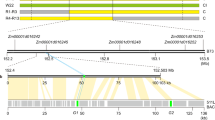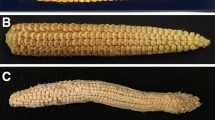Abstract
Cross-incompatibility genes known as gametophyte factors (ga) are numerous in maize. Many popcorn strains carry these genes and cannot be fertilized by pollen of dent and flint maize strains although the reciprocal crosses are successful. A Chinese popcorn strain SDGa25 carries the strongest allele of Ga1 (Ga1-S) and the majority of Chinese dent and flint maize germplasm are incompatible with SDGa25. The incompatibility is due to pollen tube growth obstruction 2 h after pollination. The pollen tube is arrested in the silk segment 5.5 cm distal to the pollination area and never reaches the ovule. The Ga1-S carried by SDGa25 behaves as a single dominant gene. This gene was mapped between markers SD3 on BAC AC200747 0.827 cM apart on the telomere side and SD12 on BAC AC204382 0.709 cM apart on the centromere side. The genetic region mapped spanning the Ga1-S locus was estimated to be 1.5 cM in length and the physical distance is 2,056,343 bp on ctg156 based on the B73 RefGen_v2 sequence. Gametophyte factors influence gene flow direction and the strongest Ga1-S allele is useful for isolating one category of commercial varieties from another. The eight tightly linked markers to Ga1-S developed in this study would greatly improve marker-assisted introgression efficiency and the fine mapping would facilitate the isolation of the Ga1-S.


Similar content being viewed by others
References
Ashman RB (1981) Failure to verify the Ga9 locus on chromosome 4. Maize Genet Coop News Lett 55:50–51
Evans MS, Kermicle JL (2001) Teosinte crossing barrier1, a locus governing hybridization of teosinte with maize. Theor Appl Genet 103:259–265
Grini PE, Schnittger A, Schwarz H, Zimmermann I, Schwab B et al (1999) Isolation of ethyl methanesulfonate-induced gametophytic mutants in Arabidopsis Thaliana by a segregation distortion assay using the multimarker chromosome 1. Genetics 151:849–863
Gupta R, Ting JT, Sokolove LN, Johnson LA, Luan S (2002) A tumor suppressor homolog, AtPTEN1, is essential for pollen development in Arabidopsis. Plant Cell 14:2495–2507
Heslop HY, Reger BJ, Harrison JH (1984) The pollen-stigma interaction in the grasses. 6. The stigma (silk) of Zea mays L. as host to the pollen of Sorghum bicolor (L) Moench and Pennisetum americanum (L) Leeke. Acta Bot Neerl 33:205–227
House LR, Nelson OE (1958) Tracer study of pollen-tube growth in cross-sterile maize. J Heredity 49:18–21
Howden R, Park SK, Moose JM, Orme J, Grossniklaus U et al (1998) Selection of T-DNA-tagged male and female gametophytic mutants by segregation distortion in Arabidopsis. Genetics 149:621–631
Jimenez JR, Nelson OE (1965) A new fourth chromosome gametophyte locus in maize. J Heredity 56:259–263
Kermicle JL (2006) A selfish gene governing pollen-pistil compatibility confers reproductive isolation between maize relatives. Genetics 172:499–506
Kermicle JL, Evans MS (2005) Pollen-pistil barriers to crossing in maize and teosinte result from incongruity rather than active rejection. Sex Plant Reprod 18:187–194
Kermicle JL, Evans MS (2010) The zea mays sexual compatibility gene ga2: naturally occurring alleles, their distribution, and role in reproductive isolation. Heredity 101:737–749
Lausser A, Kliwer I, Srilunchang K, Dresselhaus T (2010) Sporophytic control of pollen tube growth and guidance in maize. J Exp Bot 61:673–682
Nelson OE (1952) Non-reciprocal cross-sterility in maize. Genetics 37:101–124
Nelson OE (1994) The gametophyte factors of maize. In: Freeling M, Walbot V (eds) The maize handbook. Springer-Verlag, Berlin, pp 496–503
Procissi A, Lassardiere S, Ferault F, Vezon D, Pelletier P et al (2001) Five gametophytic mutations affecting pollen development and pollen tube growth in Arabidopsis thaliana. Genetics 158:1773–1783
Schnable PS et al (2009) The B73 genome: complexity, diversity, and dynamics. Science 326:1112–1115
Schwartz D (1950) The analysis of a case of cross-sterility in maize. Proc Natl Acad Sci USA 36:719–724
Acknowledgments
The authors thank China National Science Foundation (Program No.30971788), Shandong Pivotal Elite Variety Development Project (Lu 2010-6) and the Advanced Research Program from the Institute of Genetics and Development, Chinese Academy of Sciences for providing funds for carrying out the research work. The authors also thank Dr. Baoshen Liu for providing maize germplasm line SDGa25 and others used in the study.
Author information
Authors and Affiliations
Corresponding author
Additional information
Communicated by H. H. Geiger.
H. Zhang and X. Liu are contributed equally to this work.
Electronic supplementary material
Below is the link to the electronic supplementary material.
Rights and permissions
About this article
Cite this article
Zhang, H., Liu, X., Zhang, Y. et al. Genetic analysis and fine mapping of the Ga1-S gene region conferring cross-incompatibility in maize. Theor Appl Genet 124, 459–465 (2012). https://doi.org/10.1007/s00122-011-1720-7
Received:
Accepted:
Published:
Issue Date:
DOI: https://doi.org/10.1007/s00122-011-1720-7




